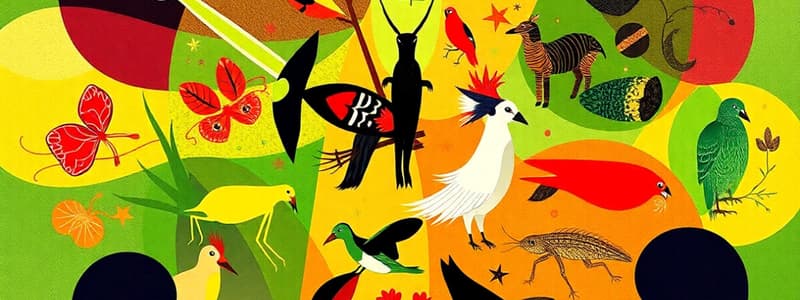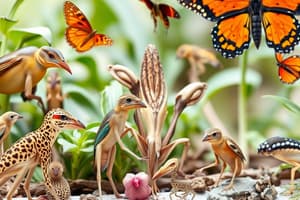Podcast
Questions and Answers
Which of the following correctly describes a mutualistic relationship?
Which of the following correctly describes a mutualistic relationship?
- Neither species gains any benefit.
- Both species benefit from the relationship. (correct)
- One species benefits at the expense of the other.
- One species benefits while the other is unaffected.
What is the primary advantage of asexual reproduction?
What is the primary advantage of asexual reproduction?
- It occurs in two specialized cells.
- It allows for rapid population increase with identical traits. (correct)
- It produces genetically diverse offspring.
- It enhances genetic variation within a species.
How does genetic variation contribute to a species' survival?
How does genetic variation contribute to a species' survival?
- It eliminates the role of chance in evolution.
- It provides a pool of traits that can help individuals adapt. (correct)
- It ensures that all offspring have the same traits.
- It results in constant traits across generations.
Which statement accurately describes antibiotic resistance?
Which statement accurately describes antibiotic resistance?
In the hierarchical classification system, which category comes immediately after 'Phylum'?
In the hierarchical classification system, which category comes immediately after 'Phylum'?
What type of variation is characterized by distinct categories, such as blood type?
What type of variation is characterized by distinct categories, such as blood type?
What role do decomposers play in an ecosystem?
What role do decomposers play in an ecosystem?
Which of the following statements about symbiotic relationships is incorrect?
Which of the following statements about symbiotic relationships is incorrect?
Why is protecting biodiversity crucial for ecosystems?
Why is protecting biodiversity crucial for ecosystems?
What defines a manipulated variable in an experiment?
What defines a manipulated variable in an experiment?
What is the primary function of a niche in ecology?
What is the primary function of a niche in ecology?
How does a decrease in predator populations typically affect prey populations?
How does a decrease in predator populations typically affect prey populations?
Why is it important to understand species diversity in an ecosystem?
Why is it important to understand species diversity in an ecosystem?
What is an example of a responding variable in an ecological experiment?
What is an example of a responding variable in an ecological experiment?
Which of the following best describes how changes in one species can impact an entire ecosystem?
Which of the following best describes how changes in one species can impact an entire ecosystem?
What practice can enhance the understanding of ecological relationships among organisms?
What practice can enhance the understanding of ecological relationships among organisms?
In the context of ecological impact, what effect does a decreased wolf population have?
In the context of ecological impact, what effect does a decreased wolf population have?
What is one of the most significant benefits of connecting biodiversity concepts to real-world issues?
What is one of the most significant benefits of connecting biodiversity concepts to real-world issues?
Which of the following techniques is NOT advisable for studying species diversity?
Which of the following techniques is NOT advisable for studying species diversity?
Which of the following statements accurately reflects the nature of niches in an ecosystem?
Which of the following statements accurately reflects the nature of niches in an ecosystem?
Flashcards
Species
Species
A group of organisms that can interbreed and produce fertile offspring. They share similar characteristics.
Biological Diversity
Biological Diversity
The variety of life forms on Earth, including different species, genetic differences within species, and various ecosystems.
Classification System
Classification System
A hierarchical system used to classify organisms based on shared characteristics, from general to specific.
Niche
Niche
Signup and view all the flashcards
Genetic Variation
Genetic Variation
Signup and view all the flashcards
Heritable Traits
Heritable Traits
Signup and view all the flashcards
Asexual Reproduction
Asexual Reproduction
Signup and view all the flashcards
Sexual Reproduction
Sexual Reproduction
Signup and view all the flashcards
Antibiotic Resistance
Antibiotic Resistance
Signup and view all the flashcards
Commensalism
Commensalism
Signup and view all the flashcards
Manipulated Variable
Manipulated Variable
Signup and view all the flashcards
Responding Variable
Responding Variable
Signup and view all the flashcards
Species Diversity
Species Diversity
Signup and view all the flashcards
Reproduction
Reproduction
Signup and view all the flashcards
Classification
Classification
Signup and view all the flashcards
Symbiosis
Symbiosis
Signup and view all the flashcards
Predator-Prey Relationships
Predator-Prey Relationships
Signup and view all the flashcards
Food Web
Food Web
Signup and view all the flashcards
Variation
Variation
Signup and view all the flashcards
Study Notes
Part 1: Knowledge-Based Concepts
- Species: A group of organisms sharing similar traits, capable of producing fertile offspring.
- Biological Diversity: Variety of life forms, including species diversity, genetic diversity, and ecosystem diversity.
- Kingdoms of Life: Five kingdoms—Animalia, Plantae, Fungi, Protista, and Monera.
- Symbiotic Relationships:
- Mutualism: Both species benefit.
- Commensalism: One species benefits, the other isn't affected.
- Parasitism: One species benefits, the other is harmed.
Classification System
- Organisms are categorized hierarchically: Kingdom → Phylum → Class → Order → Family → Genus → Species.
Niche
- An organism's role in its ecosystem, including habitat, diet, and interactions with other species.
Variation
- Genetic Variation: Differences in DNA among individuals.
- Heritable Traits: Traits passed from parents to offspring (e.g., eye color).
- Discrete Variation: Specific categories (e.g., blood type).
- Continuous Variation: Varied across a spectrum (e.g., height).
Part 2: Biological Processes
Reproduction
-
Asexual Reproduction: One parent, produces identical offspring quickly. Examples: budding, binary fission, spore production.
-
Sexual Reproduction: Two specialized cells (gametes), producing genetically diverse offspring. Fertilization is the union of sperm and egg.
Natural Selection and Adaptation
- Species with greater variation are better adapted to environmental changes.
- Natural selection favors individuals best suited to their environment.
- Antibiotic Resistance: Overuse of antibiotics leads to resistant bacteria through natural selection.
Part 3: Ecological Interactions and Relationships
-
Symbiosis Examples:
- Goby fish and shrimp: Mutualism.
- Barnacles on whales: Commensalism.
-
Food Web Roles: Producers, consumers, and decomposers represent different organism roles.
-
Human Influence and Conservation: Protecting biodiversity is crucial for ecosystem stability. Avoiding overusing resources is important to prevent species extinction.
Part 4: Application Concepts
Experimental Design
-
Variables:
- Manipulated Variable: Changed factor in an experiment (e.g., solution treatments).
- Responding Variable: Observed effect (e.g., plant growth).
-
Interpreting Data: Analyzing patterns in species diversity or environmental effects using graphs and data tables.
Ecological Impact
- Changes in predator or prey population affect the entire ecosystem. For instance, decreased wolf populations can lead to increased elk populations and decreased vegetation.
Study Tips
- Understand key terms (species diversity, niches, reproduction types).
- Practice ordering organisms hierarchically.
- Practice questions on symbiosis, reproduction, and variation.
- Visualize concepts like food webs and reproduction.
- Connect concepts to real-world issues.
- Use available resources, including AI, to clarify concepts and answer questions.
Studying That Suits You
Use AI to generate personalized quizzes and flashcards to suit your learning preferences.
Description
Explore the essential concepts of biological diversity and the classification of life forms in this quiz. Delve into species definitions, types of symbiotic relationships, and the hierarchical system of organism classification. Enhance your understanding of niches and genetic variation.




